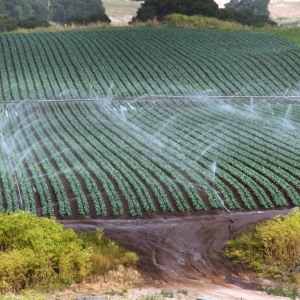
This paper finds that over ten billion people could be fed within the constraints of four planetary boundaries (biosphere integrity, land-system change, freshwater use, and nitrogen flows), if the food system undergoes a “technological-cultural U-turn”.
Today, around half of food production goes beyond local ecological boundaries, shown in the figure below.
 Image: Figure 2, Gerten et al. Current status of the four planetary boundaries. a, Biosphere integrity. b, Land-system change. c, Freshwater use. d, N flows.
Image: Figure 2, Gerten et al. Current status of the four planetary boundaries. a, Biosphere integrity. b, Land-system change. c, Freshwater use. d, N flows.
The researchers developed a scenario that stays within the confines of the four planetary boundaries considered (note that a total of nine planetary boundaries have been identified, including climate change; the authors picked four that are strongly influenced by agriculture). As shown in the figure below, if current farming and eating practices were maintained, the food system could only provide 3.4 billion people with a balanced diet (e.g. due to having to abandon some farmland in aras under ecological pressure). However, 10.2 billion people could be fed if agricultural expansion were allowed in regions where biosphere integrity is not in danger, fertiliser use increased where it would not be damaging to do so (and is made more efficient), water management improved, food loss reduced, and diets changed (with animal products providing no more than 25% of dietary protein).
 Image: Figure 1a, Gerten et al. Global population that can be provided with a global average net food supply of 2,355 kcal cap–1 d–1 (including sufficient protein content) when respecting the different planetary boundaries given unchanged current practices (left side) and when making use of opportunities of agricultural land expansion, management and sociocultural changes within the safe operating space (right side).
Image: Figure 1a, Gerten et al. Global population that can be provided with a global average net food supply of 2,355 kcal cap–1 d–1 (including sufficient protein content) when respecting the different planetary boundaries given unchanged current practices (left side) and when making use of opportunities of agricultural land expansion, management and sociocultural changes within the safe operating space (right side).
Abstract
Global agriculture puts heavy pressure on planetary boundaries, posing the challenge to achieve future food security without compromising Earth system resilience. On the basis of process-detailed, spatially explicit representation of four interlinked planetary boundaries (biosphere integrity, land-system change, freshwater use, nitrogen flows) and agricultural systems in an internally consistent model framework, we here show that almost half of current global food production depends on planetary boundary transgressions. Hotspot regions, mainly in Asia, even face simultaneous transgression of multiple underlying local boundaries. If these boundaries were strictly respected, the present food system could provide a balanced diet (2,355 kcal per capita per day) for 3.4 billion people only. However, as we also demonstrate, transformation towards more sustainable production and consumption patterns could support 10.2 billion people within the planetary boundaries analysed. Key prerequisites are spatially redistributed cropland, improved water–nutrient management, food waste reduction and dietary changes.
Reference
Gerten, D., Heck, V., Jägermeyr, J., Bodirsky, B.L., Fetzer, I., Jalava, M., Kummu, M., Lucht, W., Rockström, J., Schaphoff, S. and Schellnhuber, H.J., 2020. Feeding ten billion people is possible within four terrestrial planetary boundaries. Nature Sustainability, pp.1-9.
Read the full paper here. See also the Foodsource building block What is food security?







Post a new comment »